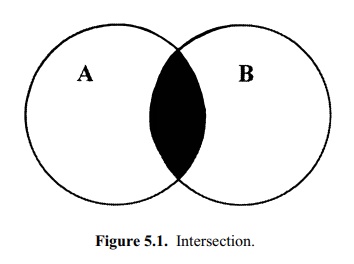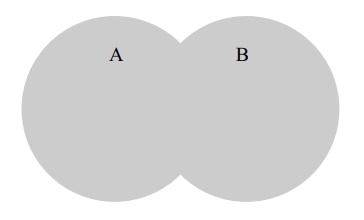Independent and Disjoint Events
| Home | | Advanced Mathematics |Chapter: Biostatistics for the Health Sciences: Basic Probability
Now we will give some formal definitions of independent events and disjoint events. But first we must explain the symbols for intersection and union of events.
INDEPENDENT AND DISJOINT EVENTS
Now we will give some formal definitions of
independent events and disjoint events. But first we must explain the symbols
for intersection and union of events.
Definition 5.3.1: Intersection. Let E and F be two events; then E
∩F denotes the event G that is the
intersection of E and F. G
is the collection of elementary events that are contained in both E and F.
We often say that G occurs only if both E
and F occur. Let us define the union
of two events.
Definition 5.3.2: Union. Let A and B be two events; then AU B denotes the event C
that is the union of A and B.
C is the collection of elementary events that are con-tained in both A and B or in either A or B.
In Example 2 (roll two dice independently), let E = {observe the same face on each die}
and let F = {the first face is even}.
Then E = [{1, 1}, {2, 2}, {3, 3}, {4,
4}, {5, 5}, and {6, 6}]. F = [{2, 1},
{2, 2}, {2, 3}, {2, 4}, {2, 5}, {2, 6}, {4, 1}, {4, 2}, {4, 3}, {4, 4}, {4, 5},
{4, 6}, {6, 1}, {6, 2}, {6, 3}, {6, 4}, {6, 5}, and {6, 6}]. Take G =
E ∩ F. Because G consists of the common elementary
events, G = [{2, 2}, {4, 4} and {6, 6}].
We see here that P(E) = 6/36 = 1/6, P(F)
= 18/36 = 1/2, and P(G) = 3/36 = 1/12. When we intersect
three or more events, for example, the events D, E, and F, we simply denote that intersection by
K = D ∩ E ∩ F. This set is the same as taking the set H = D
∩ E and then
taking K = H ∩ F, or taking G = E ∩ F and then finding K = D ∩G.
An additional point: The order in which the
successive intersections is taken and the order in which the sets are arranged
do not matter.
Definition 5.3.3: Mutual
Independence. Let A1, A2,
. . . , Ak be a set of k events (k is
an integer greater than or equal to 2). Then these events are said to be
mutually independent if P(A1 ∩ A2 ∩ . . . , Ak) = P(A1)P(A2)
. . . P(Ak), and this equality of probability of intersection to
product of individual probabilities must hold for any subset of these k events.
Definition 5.3.3 tells us that a set of events are
mutually independent if, and only if, the probability of the intersection of
any pair, or any set of three up to the set of all k events, is equal to the product of their individual
probabilities. We will see shortly how this definition relates to our
commonsense notion that independence means that one event does not affect the
outcome of the others.
In Example 2, E
and F are independent of each other.
Remember that E = {observe the same
face on each die} and F = {the first
face is even}. We see from the commonsense notion that whether or not the first
face is even has no effect on whether or not the second face will have the same
number as the first.
We verify mutual independence from the formal
definition by computing P(G) and comparing P(G) to P(E)
P(F).
We saw earlier that P(G) = 1/12, P(E) = 1/6, and P(F)
= 1/2. Thus, P(E) P(F) = (1/6) (1/2) = 1/12. So we have verified that E and F are independent by checking the definition.
Now we will define mutually exclusive events.
Definition 5.3.4: Mutually
Exclusive Events. Let A and B be
two events. We say that A and B are mutually exclusive if A∩ B = Ø, or equivalently in terms of probabilites, if P(A∩ B) = 0. In particular, we note that A and Ac are mutually exclusive events.

Figure 5.1. Intersection.
The distinction between the concepts of independent
events and mutually exclu-sive events often leads to confusion. The two
concepts are not related except that they both are defined in terms of
probabilities of intersections.
Let us consider two nonempty events, A and B. Suppose A and B are indepen-dent. Now, P(A)
> 0 and P(B) > 0, so P(A ∩ B) = P(A) P(B) > 0. Therefore, because P(A ∩ B) ≠ 0, A and B are not mutually exclusive.
Now consider two mutually exclusive events, C and D, which are also nonemp-ty. So P(C) > 0 and P(D) > 0, but P(C
∩ D) = 0
because C and D are mutually exclusive. Then, since P(C)P(D) > 0, P(C
∩ D) ≠ P(C)P(D); therefore, C and D are not independent.
Thus, we see that for two nonempty events, if the
events are mutually exclusive, they cannot be independent. On the other hand,
if they are independent, they cannot be mutually exclusive. Thus, these two
concepts are in opposition.
Venn diagrams are graphics designed to portray
combinations of sets such as those that represent unions and intersections.
Figure 5.1 provides a Venn diagram for the intersection of events A and B.
Circles in the Venn diagram represent the
individual events. In Figure 5.1, two circles, which represent events A and B, are labeled A and B. A third event, the in-tersection of
the two events A and B, is indicated by the shaded area.
Similarly, Fig-ure 5.2 provides a Venn diagram that illustrates the union of
the same two events.

Figure 5.2. Union.
This illustration is accomplished by shading the
regions covered by both of the indi-vidual sets in addition to the areas in
which they overlap.
Related Topics
